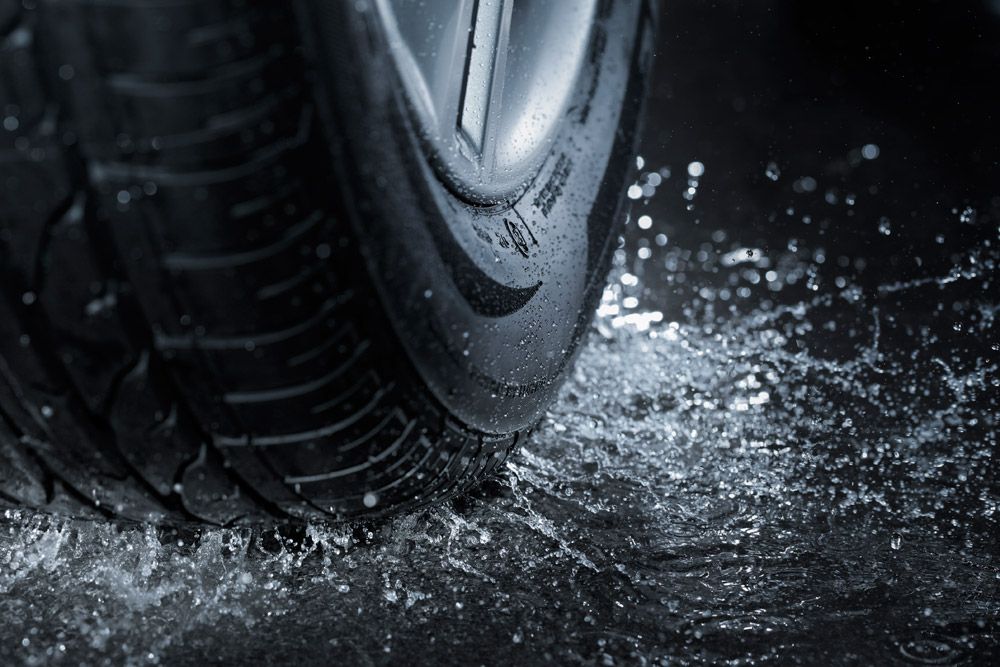A spare tire may come in handy in emergency cases like a flat tire. However, it should be used as a temporary option only because you cannot expect the same vehicle performance as regular tires provide.
So, how fast can you drive on a spare tire? The maximum speed of a spare tire is 50 mph, and you must not drive farther than 70 miles.
Else, it would cause vehicle issues like tire wear, tire blowout, flat tire, or damage to car parts.
Table of Contents
A spare tire is an additional tire carried on the trunk of a car. It can be a full-size spare tire or a donut tire.
1. With a full-size spare tire
A full size spare tire can be a matching spare tire of your traditional tires. Meaning they have the same size, weight, and perhaps, even brand.
Therefore, they don’t have specific limits, especially on the highway. You might be able to drive more than 70 miles without lowering the speed.
The max speed on spare tire will be 90 miles if you have to stretch a little to reach the destination as soon as possible.
2. With a donut tire
A donut tire, also known as a donut spare, is smaller than regular tires because it was designed to be light, space-saving, and portable. Its primary purpose is to replace a flat tire and bring your vehicle to the nearest repair shop.
Donut spares are small, light, and have minor tread construction than regular tires. Therefore, to be safe, the fastest you can go on a donut spare is 50 mph, and the farthest you can drive is not more than 70 miles.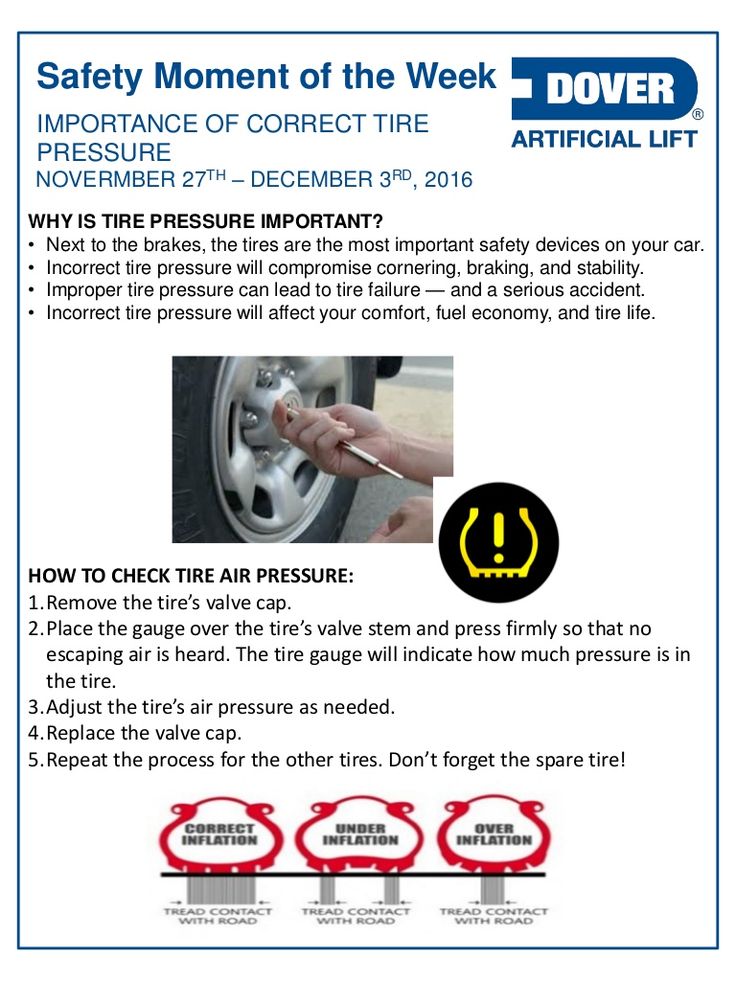
This limitation makes it unsafe to drive on a donut on the highway.
1. Tire Wear
Donut spares are smaller, lighter, and have little tread, so driving faster than 50mph will cause the wheel to work harder and lead to tire wear quickly.
2. Tire blowout
Since donut tires do not have the significant features of regular tires, exceeding spare tire speed limit will cause the tire to blow out and lose control of the vehicle.
Worst, it may lead to an accident like a car crash, vehicle collision, or hitting pedestrians.
3. Flat Tire
Donut tires are constructed with less resistance to bumps, road hazards, or projectiles. So driving them faster and longer than their service design may put them at risk for another flat tire emergency.
4. Damage to car parts
In general, when donut tires are overused, they cause damage to car parts such as:
Safety and Convenience
Suppose your full-size spare tire matches the current specifications of your regular tires.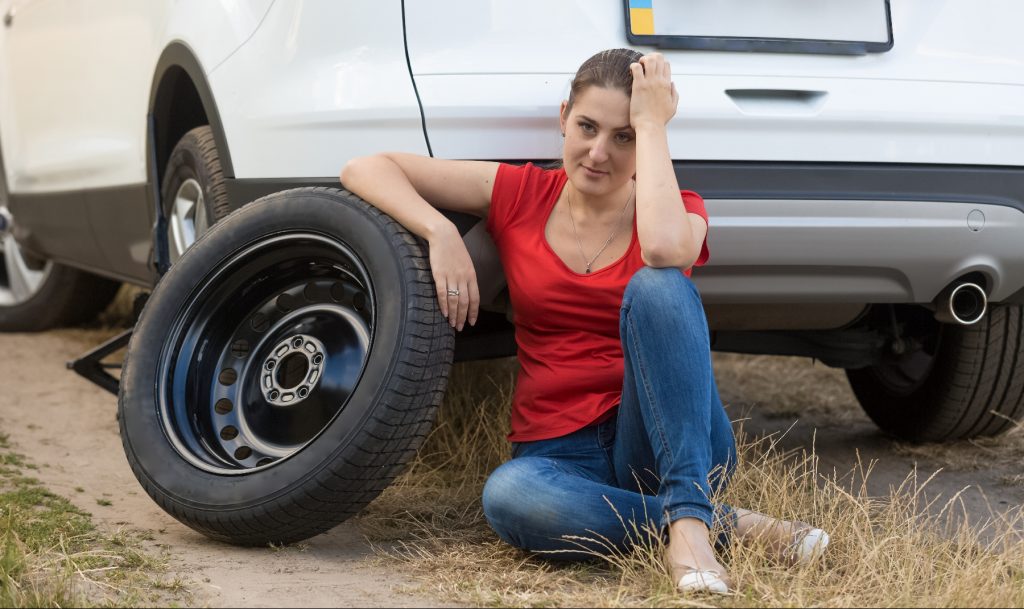 In that case, you can drive safely without worrying about another emergency.
In that case, you can drive safely without worrying about another emergency.
On the other hand, when you drive on a donut, it is advisable to quickly visit the nearest auto repair shop.
Cost
Donut spare tires cost around $50-300, while full-size spare tire may start at $100 or have the same price as your regular tires.
Don’t use the spare tire if you experience a flat tire on one of the driving wheels. Instead, get the replacement from the non-driving wheel.
Replace the tire in the non-driving wheel with the full-size spare tire. As a result, you won’t feel a big difference in ride quality.
If you put a donut tire on a driving wheel, there is a huge shift in handling because it is undersized. It may throw you off the road when you turn or slide when you brake because there is much weight to carry.
If you don’t have a choice but to use the donut tire in front, drive a short distance. Don’t take other risks. Calling a towing service is a safer option if there’s a long way to go.
Calling a towing service is a safer option if there’s a long way to go.
Driving too fast on a donut spare tire can cause flat tires, tire wear, or tire blowout, leading to loss of vehicle control and road accidents. It may also damage vehicle parts such as the brakes, steering system, suspension, and transmission.
The optimal speed for driving on a donut tire is 50 mph. Reddit users attest that driving more than 70mph is dangerous.
Can I drive a spare tire on the highway?
Indeed, driving on a spare tire on the highway is dangerous because the average speed required is 50mph.
If there is no other way, you might drive on a full-size spare tire and not a donut tire.
Not knowing how fast can you drive on a spare tire is dangerous.
Driving spare tires at more than the recommended speed of 50 mph and mileage of 70 miles will cause more damage to the vehicle, not limited to flat tires or tire blowout. Worst of all, accidents may happen.
Although full-size spare tires are ideal, they are not available for small-sized vehicles. Even if donut spare tires are not for long-term use, they are reliable for short distances.
If you want to know more about fixing flat tires, don’t hesitate to ask some questions.
If you have ever been stuck on the side of the road with a flat tire, you understand how helpful a reliable spare tire can be in an emergency.
Spare tires are great for temporary use to regain road mobility. But you should not drive over the 50 MPH limit with a spare tire or else you could experience a blowout. Spare tires also should not be driven farther than 70 miles or they could wear too quickly and lead to another flat.
Once you start driving on a spare, you will notice a significant difference in vehicle performance and capabilities based on the unbalanced feel of your vehicle. The objective of a flat is to support your vehicle, but creating an imbalance with other tires can cause damage if you use a spare for a long time. For this reason, we always recommend getting your flat tire repaired as soon as possible.
As industry experts, our team understands the risks a spare tire can present when overused with a vehicle. This is especially true for trucks and larger vehicles that require more sidewall support from their tires. In this guide, you will learn everything about how far and fast you can drive on a spare tire.
The modern-day spare tire is a necessity in any car owner's arsenal of tools. A spare is typically used in the event of a flat tire, but someone who has one around can also use it to carry extra air for when they are on the road.
A spare tire is typically carried in the trunk of a car and is designed to be used quickly when needed by inflating with an air pump or deflating to fit in the trunk of an automobile.
A spare tire can be used in place of a standard one and can reach up to 50 MPH. But, depending on how it was driven on, the life span of the spare tire will vary.
Most spare tires have a driving distance of up to roughly 70 miles. This number can go a bit higher or lower depending on how it was used. After you hit the 70-mile mark, it is time to change your spare tire as soon as possible.
It is best to treat a spare tire as a temporary option and make the change right away back to a traditional tire. Spares cause your vehicle to drive unbalanced compared to a regular tire so longer-term usage can lead to vehicle issues.
You can use a spare tire more than once but you should check the tread wear to make sure it is still ok to drive on. And it's also important to get your car serviced so that your car will be in the best shape possible when you do need a spare tire.
And it's also important to get your car serviced so that your car will be in the best shape possible when you do need a spare tire.
Spare tires are a good option for those who need to drive and use the car only occasionally. They can be useful for those who travel a lot and like to do long-distance driving.
When you use a spare tire that has worn down to the point that there is no good tread left to drive on, you need to replace it with a new one. You can still use this tire for other uses after replacing it with a new one, but your chances of getting another ride are not very high.
Typically, these spare tires come with indicators on the tire and tread to show you whether they are worn too much to keep driving. It is best to also remember the last time you used it and for how long to help figure out whether or not it can be used again.
If your spare tire fails while on the road, there's a good chance your car will slip out of control and crash.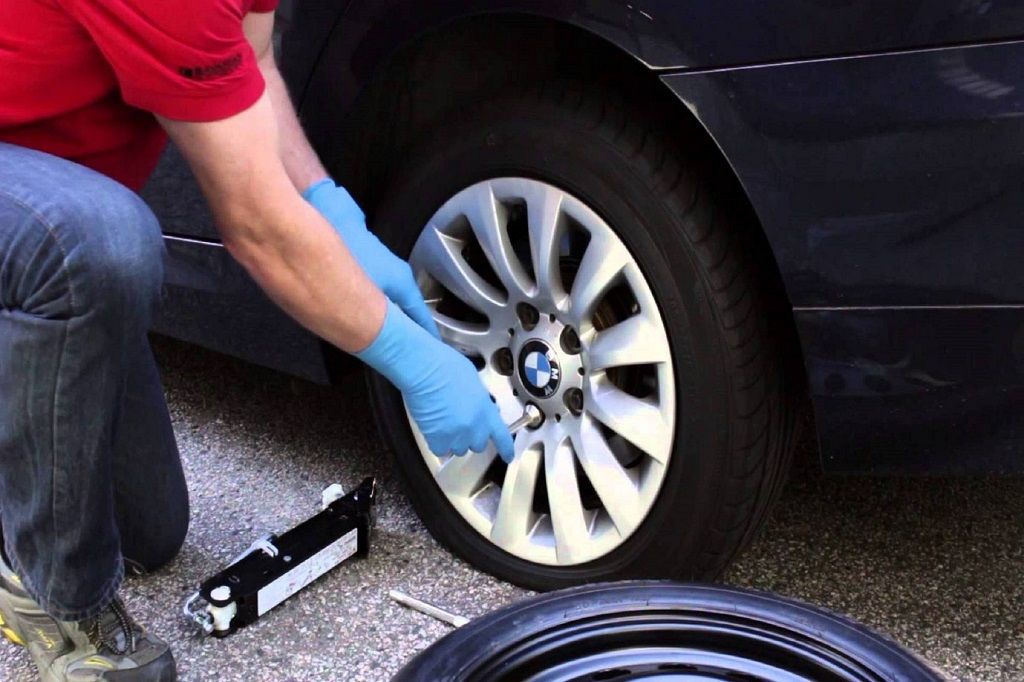 This is why it's important to always have a full set of tires on hand so that there isn't any danger in case something goes wrong.
This is why it's important to always have a full set of tires on hand so that there isn't any danger in case something goes wrong.
A spare tire is only intended to be used for a limited time so you must drive slowly on it. Driving too fast may cause the vehicle to blow out, causing damage to your car.
If someone drives too fast on a spare tire, they could cause the vehicle to fail or blow out and cause damage. Driving fast also makes cars more likely to lose control and hit other vehicles or pedestrians on the road.
The risks are even higher with a spare tire than experiencing a blowout on a traditional street tire. Your vehicle is already unbalanced, so a blowout will cause it to lose control much more erratically resulting in a dangerous crash.
When driving on a spare tire, it is best to drive slower than usual based on your vehicle's speedometer reading. Simply keep your speed under 50 MPH to stay safe and avoid any unnecessary risks on the road.
While it is not illegal to drive on the highway with a spare, you should avoid doing so because the average highway speed is above 50 MPH and it will put you at too high of a risk of exceeding this speed limit and putting you and your vehicle at risk.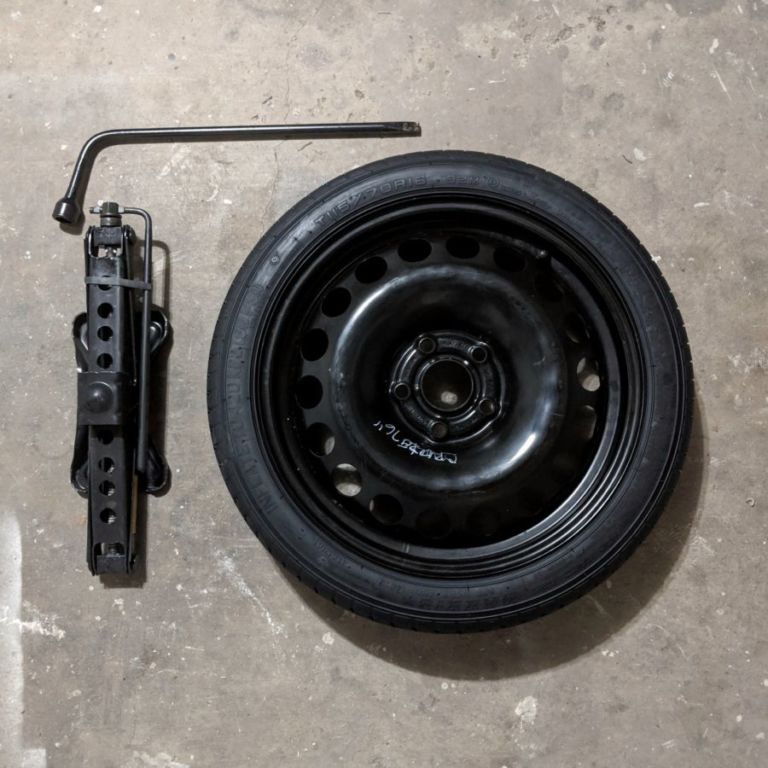
There may be some highways with lower speed limits and if you can keep the speed low enough, there would not be a problem with driving on the highway. However, the biggest concern is speed.
Highway driving may also indicate you are driving longer distances and this should be avoided at all costs too. It is best to bring your vehicle directly to a repair shop after a flat to get a new tire and have your temporary spare removed.
The spare tire can also get damaged or punctured while driving on the highway. The spare does not have a traditional sidewall construction that creates resistance against punctures, so there are plenty of ways you could experience issues on the highway.
0003Related materials
Wheels: what you need to know when choosing?
A stowaway is any spare wheel with a wheel and tire size that differs from the dimensions of the wheels mounted on the vehicle. Also, the tire model must be identical to the main set of tires. Manufacturers usually use a stowaway to save space in the luggage compartment and reduce the cost of the car.
Manufacturers usually use a stowaway to save space in the luggage compartment and reduce the cost of the car.
However, not all cars have a stowaway. On European cars, the probability of seeing a dokatka in the trunk, or even just a tire repair kit, is higher. But Japanese, Korean, and especially Chinese manufacturers often prefer a full-fledged fifth wheel, and even on an alloy wheel. This is a kind of adaptation to bad roads in those countries where their products will travel. On such a spare wheel, of course, you can ride for as long as you like, but! All this applies only to the summer season. After all, any spare wheel (be it a full-size spare wheel or a dokatka) implies a summer tire. And a summer wheel in addition to three winter ones will already be a dokatka. Even an inexperienced driver will feel something is wrong with the behavior of such a car. Therefore, when using a dokatka in winter, it is important to observe the following rule:
If civilization, where you can repair a punctured tire or buy a new one, is far away, then the stowaway should be installed on the rear axle, albeit at the cost of a double rearrangement of the wheels.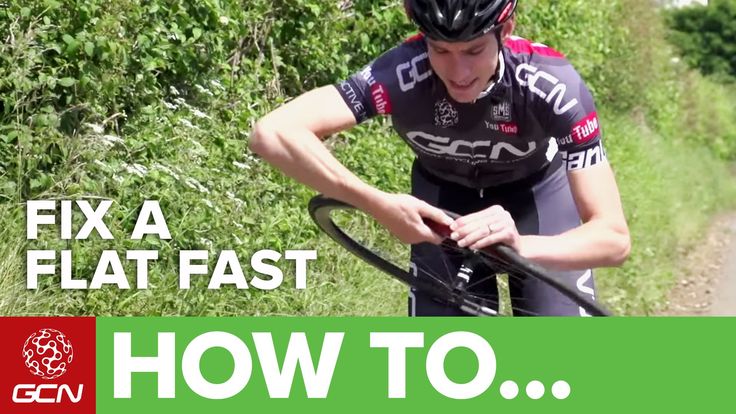 This also applies to rear wheel drive vehicles. They have rear wheels for good acceleration, and front wheels for good braking. And what is more important to you?
This also applies to rear wheel drive vehicles. They have rear wheels for good acceleration, and front wheels for good braking. And what is more important to you?
Related materials
If I change wheels, do I need to balance them every season?
However, the dokatki are also different. The pressure inside the tire depends on its type. The pressure in most cases is indicated on the same plate as the pressure in all wheels. Often it is indicated on the tire itself or, in case of loss of this information, you should look at the instructions for the car. Sometimes manufacturers put a spare wheel in the trunk with a tire as wide as the rest of the wheels or slightly different, but mounted on a steel rim smaller than the rest of the wheels, in diameter. Often this wheel is “taken” from the basic configuration of the same car. The outer diameter of such a spare tire will be the same, but the ratio of the height and width of the tire will be different. The pressure in such a spare wheel must be the same as that prescribed by the manufacturer for ordinary car wheels.
The pressure in such a spare wheel must be the same as that prescribed by the manufacturer for ordinary car wheels.
Another type of dokatka is a wheel with a normal disk of nominal diameter and a tire with a low (2–4 mm) tread. With such a wheel, you have to be even more careful in winter due to the low tread height. Even if it is installed on the rear axle, the car can easily skid. The pressure in such a wheel is usually slightly higher than that recommended by the manufacturer for other wheels.
Related materials
What if you put bigger wheels? — expert examination of the ZR
But most of all in the Russian outback, with its usually broken roads, they do not like classic Euro-rollers. A thin and narrow steel disk, a tire with a profile not much wider and higher than a mountain bike, but, unlike the latter, the tread height resembles half-worn inscriptions on ancient plates. In my opinion, on our roads such a wheel should only be on the rear axle, even in summer.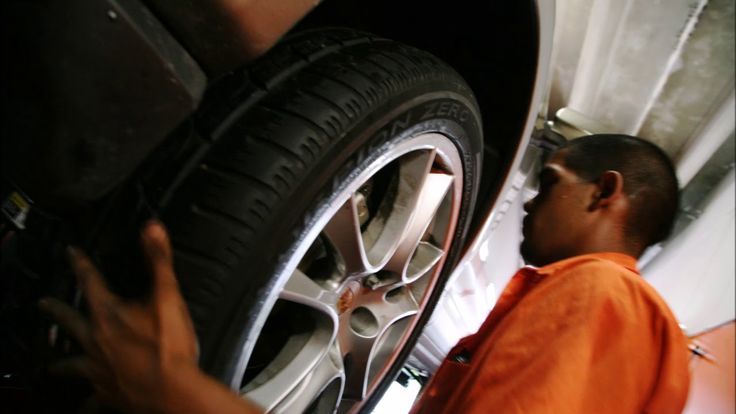 It is very easy to break through it on uneven roads like pits or tram rails. If, at the same time, the Euro-roller is installed on the rear axle, it will be easier for the driver to control and stop the car. Yes, and do not forget that the pressure in such a stowaway should be very high: up to 4.2–4.5 bar.
It is very easy to break through it on uneven roads like pits or tram rails. If, at the same time, the Euro-roller is installed on the rear axle, it will be easier for the driver to control and stop the car. Yes, and do not forget that the pressure in such a stowaway should be very high: up to 4.2–4.5 bar.
And one more thing: even when operating in the summer, be sure to observe the speed limit, which is written on any dokatka. As a rule, it is 80 km/h.
The main thing: on any dokatka there is an inscription "Temporary use only" ("Temporary use"). That says it all. The less you drive on any of the docks, the better. Of course, in theory, even a Euro-roller can withstand several thousand kilometers in terms of its physical properties. But at the same time, the tread will remain less and less. Will it ever be needed again?
Good luck on the road and take out the spare tire less often!
Our new video
9-seater Niva test! And unusual Grants
3 sincere misconceptions when transporting children
50 l / 100 km, automatic, air suspension - test of the most popular car of the USSR
Did you like the article? Subscribe and you will always be in the know!
Driving on Yandex. Zen
Zen
In case of a breakdown of a wheel on the road, each car manufacturer provides a road kit, which consists of a jack, a balloon wrench and an alternative to a broken wheel - the fifth wheel (spare). "Reserve" can be of two types - full-size or dokatka. About how to competently ride each of them - below.
What is better - a full-size or a full-size tire?
The fact that the wheel is punctured may indicate:
Stand on the side of the road and do the following:
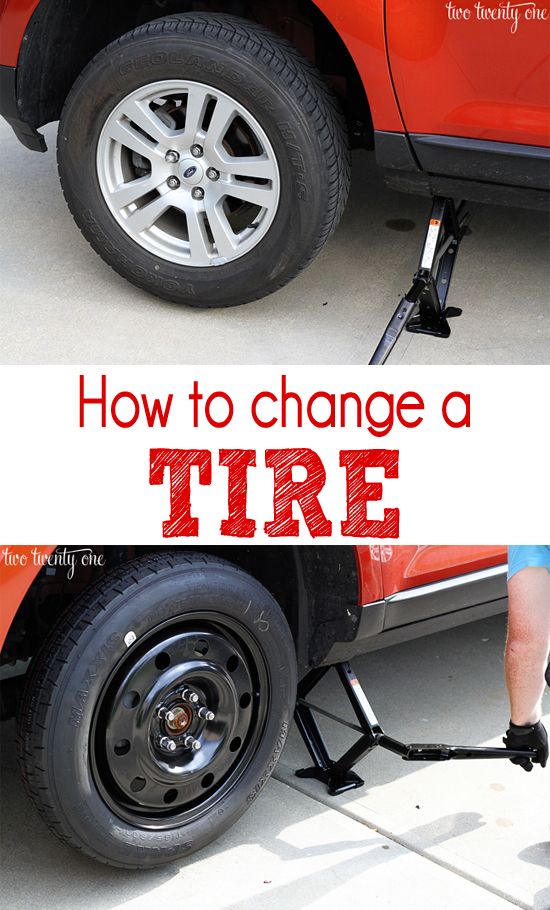
Driving with this type of fifth wheel does not require any restrictions and high speeds can be maintained while driving. But, if the tread or type of wheel (for example, a summer “reserve” when driving in winter) differs from those installed on the car, then you need to remember that in this case there is an imbalance in grip. It is necessary to brake smoothly and not to make sudden maneuvers to avoid the occurrence of drifts.
The dock is a kind of alternative to the full size spare wheel . It does not take up much space in the trunk and is light in weight. The tread, dimension and width of the dokatka also differ significantly from a conventional wheel.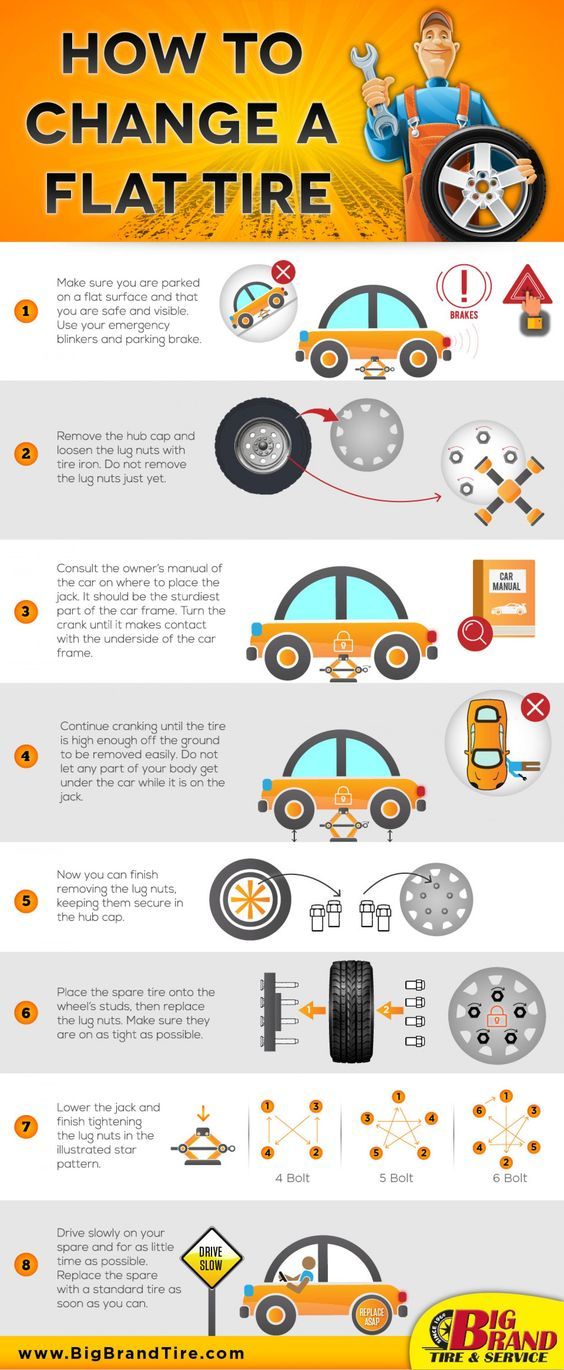 Therefore, when starting to move on the dokatka, you must adhere to the following rules:
Therefore, when starting to move on the dokatka, you must adhere to the following rules:
Result: A full-size spare tire is much preferable to a stowaway, especially on a long journey where there is no tire service for many kilometers. A dokatka can save a lot of space in the trunk and weigh little, but the disadvantages in distance and speed can be significant when driving for long distances. Therefore, it is better to use it in urban operation.
Unforeseen situations on the road are not uncommon. A tire puncture is one of them, and it is very unpleasant. Movement in this case becomes unsafe. In this case, the car should always have a “spare tire” that can be quickly replaced by a punctured wheel. But this is only a temporary option, which is forgotten by some motorists who then continue to drive for such a long time.
In this case, the car should always have a “spare tire” that can be quickly replaced by a punctured wheel. But this is only a temporary option, which is forgotten by some motorists who then continue to drive for such a long time.
Signs of a breakdown are easy to notice on the go:
In this case, immediately stop on the side of the road and check the wheels. If one of them is empty, it's time to get an emergency sign from the trunk and install it. Then you need to loosen the nuts on the punctured wheel, jack up the car, and put the spare tire on. The spare tire must be pumped up to the desired pressure before driving.
After that, you can continue driving, but to the nearest service station or car shop to fix a flat tire or buy a new one.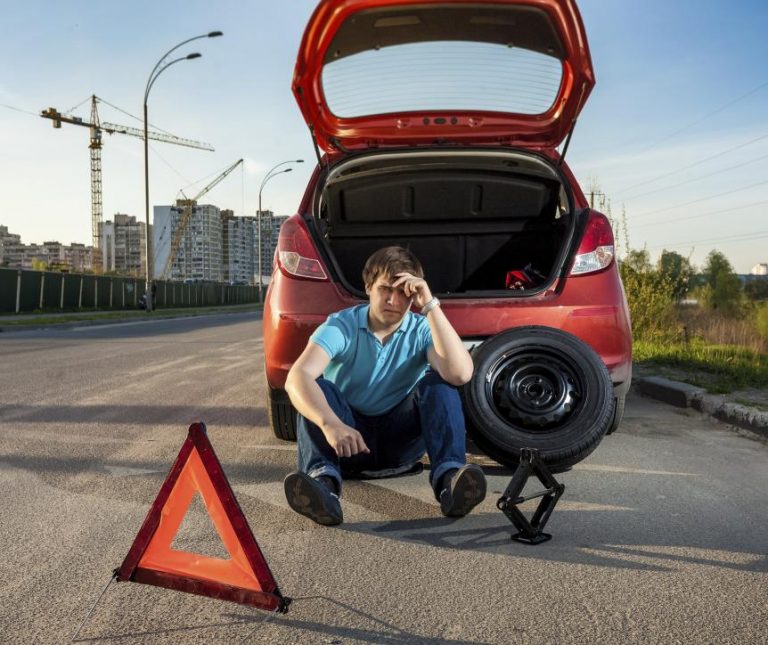 Moreover, driving on a spare wheel is allowed at a speed of no more than 90 km / h, and even less is better, since handling will be worse, and the spare wheel is not always a full-fledged wheel.
Moreover, driving on a spare wheel is allowed at a speed of no more than 90 km / h, and even less is better, since handling will be worse, and the spare wheel is not always a full-fledged wheel.
In any case, you never have to drive long and far on the spare tire. Its purpose is to get to the nearest service station to repair a punctured tire. The spare tire, even if it is a full-size one, differs from all others in its characteristics and is short-lived. Moreover, if you put it, then there is simply no second one if another such trouble happens. Therefore, it must be returned to the trunk as soon as possible.
Its purpose is to get to the nearest service station to repair a punctured tire. The spare tire, even if it is a full-size one, differs from all others in its characteristics and is short-lived. Moreover, if you put it, then there is simply no second one if another such trouble happens. Therefore, it must be returned to the trunk as soon as possible.
All of the above applies to the summer period - you can ride on a spare tire exactly as long as you need to get to the nearest car service. And no more than 80-100 km in distance.
In winter, this rule also applies, but you need to act as quickly as possible and do not delay repairs. The fact is that the spare wheel usually has summer tires, and even then it has a very low tread. Therefore, even just getting to a place with it will be difficult, as the car's handling is greatly deteriorating.
To compensate a little, the spare wheel must be put on the rear axle, even if the front axle is pierced - then the rear one is simply rearranged forward. Otherwise, every time you accelerate and decelerate, the car will turn to the side.
Otherwise, every time you accelerate and decelerate, the car will turn to the side.
Some car manufacturers fit their models with full-size spare wheels, just like the rest. Theoretically, you can ride it until it is completely worn out. But in practice it is not necessary to do this, for the following reasons:
Such a wheel not only initially has a bad effect on handling, but over time it will wear out faster than others, breaking the balance more and more. Therefore, in the end, you will soon have to buy new tires. Yes, it's not far from the accident.
Important! Any spare tire is only for getting to the nearest car repair shop. Its long-term operation is not provided!
Of course, if you take care in advance and put a high-quality tire according to the season, then there will be no problems.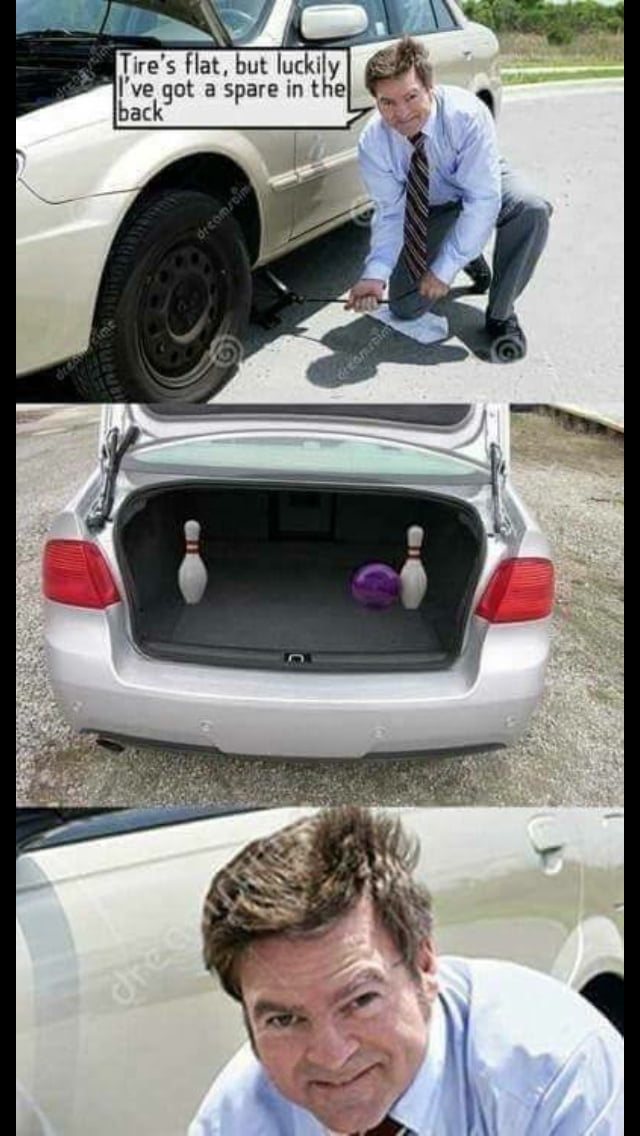 But so few people do.
But so few people do.
Landing - an emergency wheel of reduced size. It has a smaller tread width, and the height is also usually reduced. It needs to be pumped up much harder, and as a result, the outer diameter becomes normal for this car. European models are usually equipped with dokatka, as the roads in Europe are good, and on such a spare tire you can easily get to repairs. In addition, it saves space in the trunk.
With the only advantage - small dimensions, the dokatka has many disadvantages:
 Even on an excellent flat track, you can not accelerate more than 80 km / h. Plus, it will be easier to manage.
Even on an excellent flat track, you can not accelerate more than 80 km / h. Plus, it will be easier to manage.
Therefore, using such a spare tire, immediately move towards the nearest service station, where you can repair or buy a normal wheel. It is not for nothing that the stowaway is called an emergency option - on it you can only get to the repair. Sometimes you still have to call a tow truck, especially if the roads are not even close to European ones.
A car's spare tire is a great help in the event of a car tire failure, but most spares are not meant to be permanently used as a main wheel. Our online publication 1GAI. RU decided to find out why you can’t drive a spare tire for a long time and what is a car spare tire?
RU decided to find out why you can’t drive a spare tire for a long time and what is a car spare tire?
Not all spare tire tires are the same. Often at the factory, the car is equipped with a spare tire, a much smaller diameter than the main wheels of the car. Also, temporary car spare wheels most often do not have a long period of use as the main wheel. Unlike a conventional spare tire, the sidewalls use rubber with one layer of polyester and only two bands of steel, with a layer of polyester on the tread. Therefore, the spare wheel is not intended for permanent use, as the spare wheel tire will quickly become unusable from the road surface.
As a rule, spare wheels in cars are much lighter than traditional wheels. This is done so that almost any driver can easily put a spare tire instead of a damaged wheel on their own, and also in order not to add extra weight to the car. The small diameter of the spare tire is made to save space for storing it in the car.
However, due to the small diameter and weight of the spare wheel, unlike a conventional wheel, the main safety criteria for automobile wheels - durability and reliability - suffer.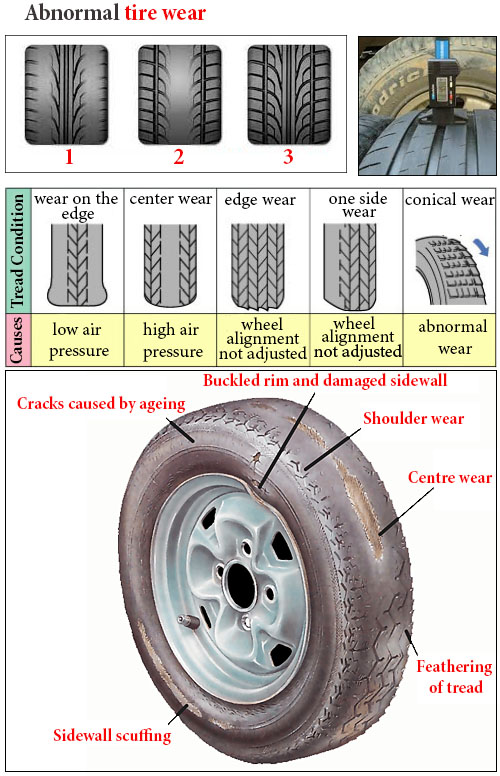
Most factory spare wheels have a speed limit of 90 km/h. But there are also faster spare wheels, on which you can accelerate to 110 km / h. This speed is enough so that in case of a puncture or damage to the tire of your wheel, you can quickly get to the nearest tire service or car repair shop on the spare wheel.
Note that some car manufacturers complete their cars with full and full-size spare wheels. Although such spares take up more space and are much heavier than smaller ones, they are durable and reliable. These spare tires will last a very long time. Including such spare wheels look exactly the same as the main wheels of a car configuration, which will allow you to ride them for a long time.
But not everything is so simple. Some spare wheels, which practically do not differ in appearance and reliability, are still not recommended for use for a long time. So, unlike traditional wheels, such a spare tire may have a different tread or a different rubber compound.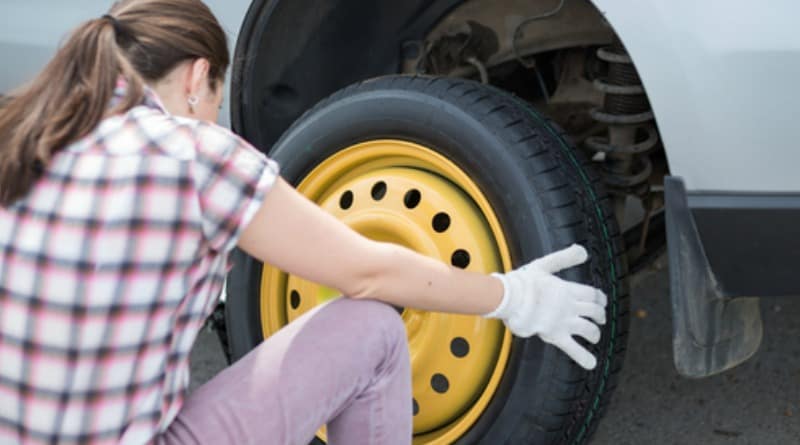 This can affect handling and safety on the road. Despite their durability and the same appearance as the main wheels of the car, these spares are designed to allow you to get far enough to the tire shop or tire shop.
This can affect handling and safety on the road. Despite their durability and the same appearance as the main wheels of the car, these spares are designed to allow you to get far enough to the tire shop or tire shop.
If your car does not have a spare tire, we recommend that you purchase a spare tire and put it in the trunk. But there are cars that do not initially have a spare wheel. This is especially true in compact cars. But some automakers have provided for such cars a way out in case of a tire puncture. For example, BMW 1 Series vehicles and MINI vehicles do not have a spare wheel. But instead, cars use Run-Flat tires (runflat), which, in the event of a puncture or damage to the tire on the road, do not allow the pressure in the tires to decrease, which allows you to get to a car service or tire fitting without changing the damaged wheel to repair the damage. On such tires, as a rule, it will be possible to drive up to 80 kilometers after damage.
But besides the convenience with these tires, there are also difficulties.